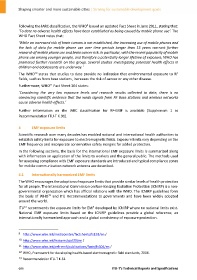Page 616 - Shaping smarter and more sustainable cities - Striving for sustainable development goals
P. 616
9
Following the IARC classification, the WHO issued an updated Fact Sheet in June 2011, stating that:
‘To date no adverse health effects have been established as being caused by mobile phone use’. The
WHO Fact Sheet notes that:
‘While an increased risk of brain tumors is not established, the increasing use of mobile phones and
the lack of data for mobile phone use over time periods longer than 15 years warrant further
research of mobile phone use and brain cancer risk. In particular, with the recent popularity of mobile
phone use among younger people, and therefore a potentially longer lifetime of exposure, WHO has
promoted further research on this group. Several studies investigating potential health effects in
children and adolescents are underway.’
10
The WHO states that studies to date provide no indication that environmental exposure to RF
fields, such as from base stations, increases the risk of cancer or any other disease.
11
Furthermore, WHO Fact Sheet 304 states:
‘Considering the very low exposure levels and research results collected to date, there is no
convincing scientific evidence that the weak signals from RF Base stations and wireless networks
cause adverse health effects.’
Further information on the IARC classification for RF‐EMF is available (Supplement 1 to
Recommendation ITU‐T K.91).
4 EMF exposure limits
Scientific research over many decades has enabled national and international health authorities to
establish safety limits for exposure to electromagnetic fields. Exposure limits vary depending on the
EMF frequency and incorporate conservative safety margins for added protection.
In the following sections, the basis for the international EMF exposure limits is summarized along
with information on application of the limits to workers and the general public. The methods used
for assessing compliance with EMF exposure standards are introduced and typical compliance zones
for mobile communication network antenna are described.
4.1 Internationally harmonized EMF limits
The WHO encourages the adoption of exposure limits that provide similar levels of health protection
for all people. The International Commission on Non‐Ionizing Radiation Protection (ICNIRP) is a non‐
governmental organization which has official relations with the WHO. The ICNIRP guidelines form
12
the basis of WHO and ITU Recommendations to governments and have been widely adopted
around the world.
13
ITU recommends the exposure limits for EMF developed by ICNIRP where no national limits exist.
National EMF exposure limits based on the ICNIRP guidelines provide a global reference, an
internationally harmonized approach and a global consistency of exposure protection.
____________________
9 http://www.who.int/mediacentre/factsheets/fs193/en /
10 http://www.who.int/features/qa/30/en /
11 http://www.who.int/peh‐emf/publications/facts/fs304/en /
12 WHO, Framework for developing health‐based electromagnetic field standards, 2006.
13 Recommendation ITU‐T K.52.
606 ITU‐T's Technical Reports and Specifications

